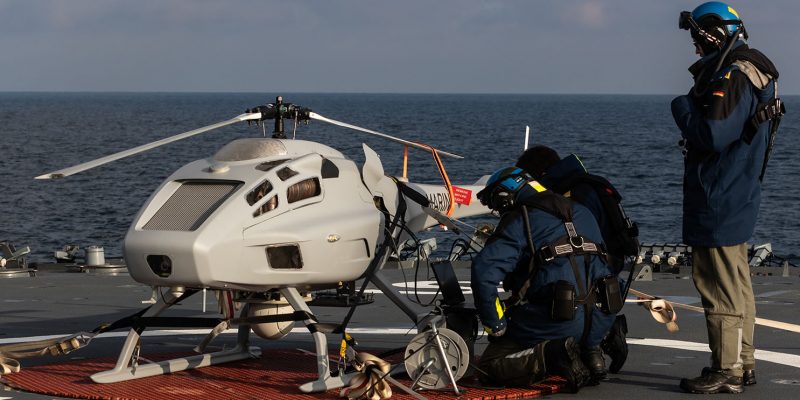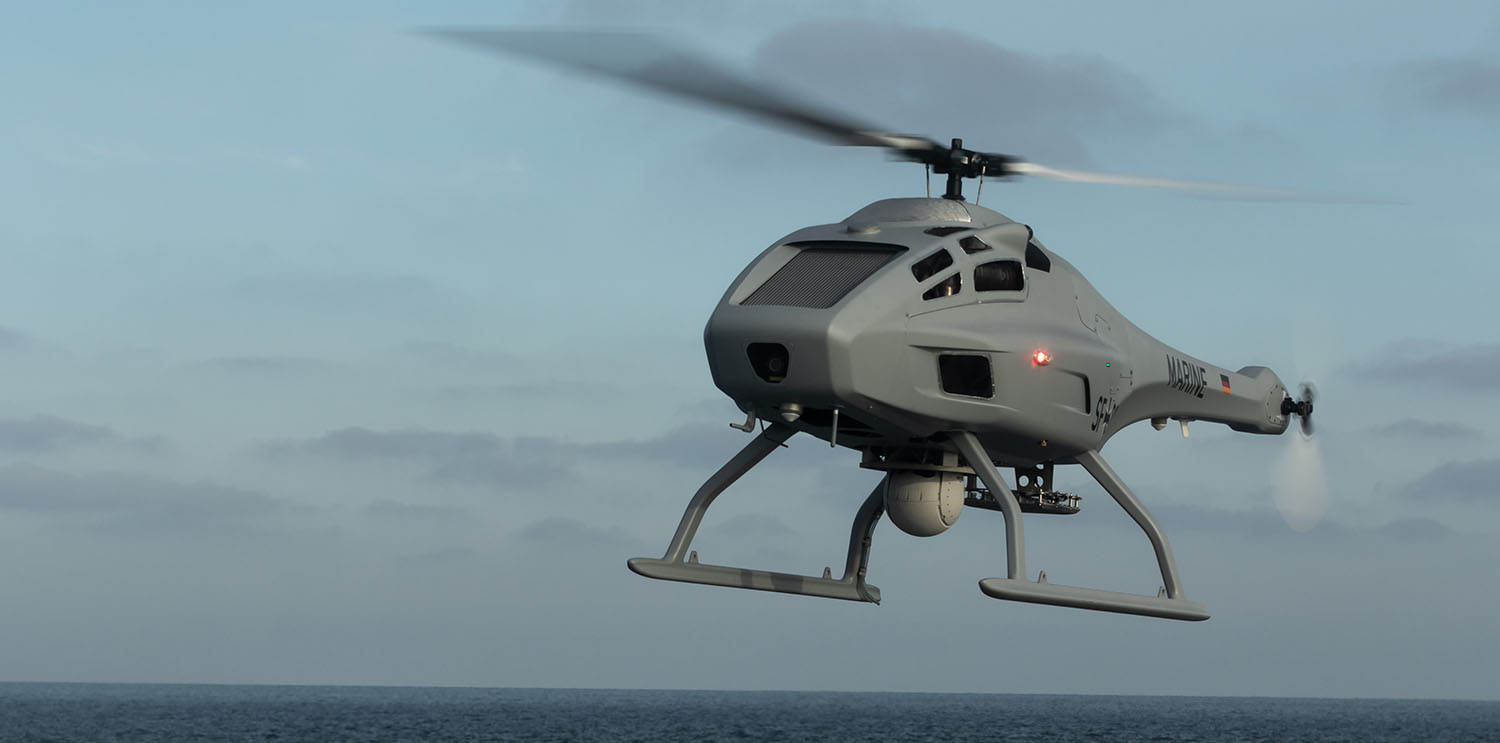Unmanned systems will become increasingly important in the German Navy in the future. The VorMUAS project is currently taking centre stage for the corvettes.
The idea of unmanned aviation is as old as aviation itself. The military has always been the driving force behind the development of such unmanned systems due to the wide range of possible applications. With the rapidly advancing technologies of our dawning information age, new outstanding opportunities for unmanned aerial vehicles are opening up, revitalising applications in the military sector.
In the German Navy, this development is taking place against the backdrop of a fundamental, future-orientated change in naval aviation. We are currently experiencing the transition to a modern fleet of aircraft, which means that the tasks of flying and technical personnel need to be rethought and redefined. However, advancing digitalisation and automation is not just happening in the cockpit. Remotely piloted and therefore unmanned aircraft represent the next stage of development and will play an increasingly important role in the fulfilment of naval aviation missions in the future.

View into the interior of the Sea Falcon
Project VorMUAS
With the introduction of the corvette 130 in 2008, it was already clear that unmanned aerial vehicles (UAVs), as an organic part of the corvettes, would represent the extended eye in the operational area and thus take on reconnaissance tasks. In order to complete the capabilities of the corvettes in the creation of situation pictures as quickly as possible, the Urgent Marine Unmanned Aircraft System (VorMUAS) project was launched for the Navy's corvettes in 2016.
A year later, the decision was made to procure a system with two Skeldar V-200 UAVs from UMS Skeldar, a joint venture between UMS Aero and Saab. The German company ESG Elektroniksystem- und Logistik-GmbH is responsible for supporting the system, which is known as Sea Falcon in the navy.
The Skeldar V-200 is a VTOL (Vertical Take-off and Landing) system with a 55 hp twin-cylinder engine that runs on standardised NATO aviation fuel. The UAV weighs over 200 kilos, has a two-bladed rotor with a diameter of 4.6 metres and resembles a smaller helicopter. With a flight time of up to five hours, a range of 100 kilometres, a service ceiling of 10,000 feet and a speed of up to 150 kilometres per hour, the Sea Falcon with its sensors is a powerful reconnaissance system.
A ground control station (BKS) is installed in the corvette's operations centre to control the Skeldar V-200. From here, an unmanned aircraft pilot (ULfzFhr) can issue manual commands to the Sea Falcon or have pre-planned waypoints flown. If required, a second pilot can take over the operation and evaluation of the Sea Falcon's sensors. With the help of a so-called deck finder on the landing deck of the corvette, the UAV takes off and lands independently. Two highly qualified aircraft technicians are also part of the on-board UAV operations team (BET UAV), which is commanded on board from the Nordholz naval air base. They carry out the maintenance and repair of the two UAVs on board.
The centrepiece of the Skeldar V-200 is the sensor head under the fuselage of the UAV. The UAV uses this to send high-resolution live images from the optical and infrared spectral range to the BKS. Another camera in the fuselage provides a forward view. With the features of the Skeldar V-200, the K 130 completes its capabilities in the areas of maritime surveillance, reconnaissance, identification and security in the operational area. As an extended arm and thus as an additional means of reconnaissance for the corvette, the Sea Falcon complements and improves the creation of the maritime pictures, of the situation picture over water and provides support for tasks in the area of imagery intelligence in the medium and long range.
Test status
After extensive preparations, operational testing on the corvette Braunschweig began in November 2020. This was preceded by tests and flight demonstrations of the UAS in Sweden at the company UMS under the direction of the Wehrtechnische Dienststelle (WTD) 61 and the conversion of the corvette for adapted flight operations of the Sea Falcon from on board. The flying and technical personnel have been undergoing specialised training for this since January 2020. For this intensive training of the pilots, flight hours first had to be completed in the simulator and then in real flight over land. The technicians underwent very detailed system training. All personnel were trained by UMS on the Skeldar V-200 system.
In order to achieve operational readiness, which is the prerequisite for acceptance into the German Navy, the new technology must now be tested under the harsh conditions on board the corvette. In addition to the many functional tests, the practical training of the pre-MUAS personnel at sea must also be completed at the same time. A mammoth task given the tight schedule: In June, the corvette Braunschweig is due to sail on the Unifil mission - with the Sea Falcon on board.
Everyone involved in the VorMUAS project is entering uncharted territory, which brings its own challenges. The operational test, which was recently delayed due to the corvette's tight schedule, difficult weather conditions and the necessary technical fine-tuning, must be completed by June. This will allow Unifil to gain important experience with the new reconnaissance system in the second half of the year.
Outlook
The AImEG project (reconnaissance and identification in the maritime operational area) is the original, more time-intensive measure to enable the K 130 with UAV-supported reconnaissance. The Sea Falcon is also planned for this. Although the same unmanned system will operate in VorMUAS and AImEG, both projects must be viewed independently of each other. Compared to AImEG, the VorMUAS project is a precursor with a significantly smaller scope. The AImEG project comprises the procurement of three further systems, one of which is intended for operation at the Nordholz site for training and education purposes. One system consists of two UAVs, a BKS as well as tools and spare parts. In addition, more extensive measures are planned with AImEG in terms of personnel, logistics and infrastructure, which are designed for comprehensive, long-term operation. The systems are scheduled to be delivered from mid-2023.
The challenge for the navy, and in particular for naval aviators, is now to incorporate the experience gained with VorMUAS into the further development of the Sea Falcon reconnaissance system in the AImEG project wherever possible. Looking further into the future, it is also conceivable that UAVs in the navy will be equipped with sonobuoys to conduct reconnaissance under water or with ESM equipment and radar to further increase reconnaissance performance in the electromagnetic spectrum.
Conclusion
Although the use of unmanned systems on board corvettes presents our navy with new challenges, it also harbours considerable potential for further development. Automatic take-off and landing on board in this form is a novelty on our seagoing units. To a large extent, it requires a rethink of previous procedures as we know them from organic, manned flying on board. In the foreseeable future, the significant advantage of UAVs in terms of endurance and operating costs compared to manned aircraft will mean that unmanned aviation will make up a larger part of the two- and perhaps even three-dimensional reconnaissance performance in the navy. These far-reaching changes will require a departure from traditional perspectives in all areas of the Bundeswehr and present us with new, exciting challenges as well as permanently changing the future approach to mission fulfilment.

Getting ready for deployment on the corvette Braunschweig
Lieutenant-Captain Fabian Henning is Head of the Planning, Principles, Concepts and Development Department at the Naval Aviation Command.
Photos: German Armed Forces












0 Kommentare